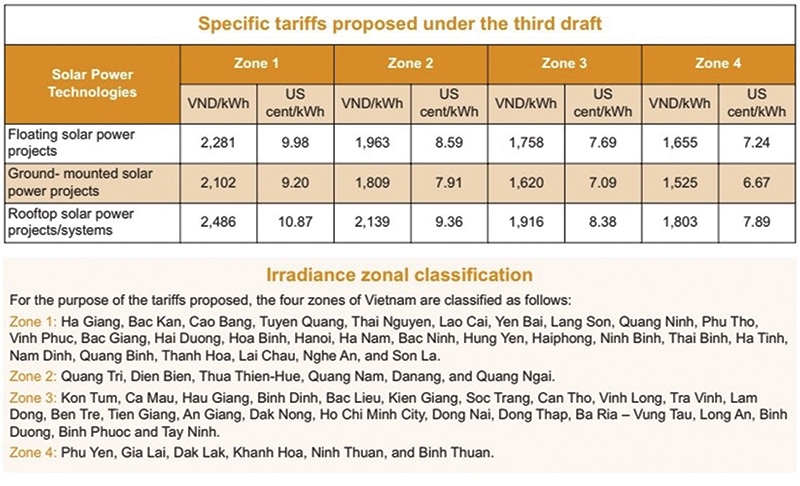Binh Thuan looks for solar solutions
 |
The move is one of the key recommendations from the Binh Thuan People’s Committee, and will be reflected upon at the seventh session of the 14th National Assembly scheduled to take place from May 20 to June 13, 2019.
“According to the latest draft from the Ministry of Industry and Trade (MoIT), the calculation that the feed-in tariff (FiT) for solar projects depend on the potential of solar radiation is not yet grounded,” noted a Binh Thuan document. “It is necessary to calculate more economic and technical effects such as local socio-economic development, reducing investment costs of power and grid, and operating costs.”
The document went on to suggest that the FiT should be the same for solar project regardless of location.
Under the MoIT’s third draft of the decision of the prime minister on the mechanism for encouraging the development of solar power projects in Vietnam, a new FiT programme would be provided for an additional two years from July 2019 through to the end of June 2021 for solar power projects in the country.
The draft decision proposes varying levels of tariffs according to location and technology, classified by four different irradiance regions of Vietnam and involving four different solar power technologies. Specifically, it provides for a wide range of tariffs which vary in the range from 6.67 cents per kilowatt hour (kWh) to 10.87 cents per kWh. Under that, the six provinces of Ninh Thuan, Binh Thuan, Khanh Hoa, Dak Lak, Gia Lai, and Phu Yen are placed into a new group of irradiance zonal classifications known as Zone 4, which will see the lowest tariff rates, ranging from 6.67 to 7.89 US cents per kWh depending on solar technologies, with some exceptions in Ninh Thuan (see box).
A solar farm developer in Binh Thuan who declined to be named said, “Many projects are racing to power and operate commercially before June 30 to enjoy a preferential price of 9.35 US cent per kWh. After this time, with the electricity price that the MoIT has drafted, especially the FIT in Binh Thuan and Ninh Thuan, I think that many businesses will no longer be interested in investing.”
Previously, Binh Thuan asked that the deadline be extended to the end of 2020 for solar investors to enjoy 9.35 US cents, instead of June 30. It has been difficult for solar power projects in the province to be completed and generate power before the June 30 deadline as many of them are located in areas of national titanium reserves and must wait for approval from the prime minister before implementation.
Binh Thuan’s solar development planning scheme towards 2020 has been waiting for MoIT approval. Some 90 solar projects were registered in the province with the total output of 5,341 megawatt peak (MWp), covering total area of 6,720 hectares, and having the total capital of VND137.2 trillion ($5.97 billion). Of them, 28 projects with the total capacity of 1,475MWp were added to the national and provincial power plan. Twenty-three projects were granted investment certificates, and investors pledged to start construction by the end of 2018 and generate power before June 30, 2019.
What the stars mean:
★ Poor ★ ★ Promising ★★★ Good ★★★★ Very good ★★★★★ Exceptional
 Tag:
Tag:
Related Contents
Latest News
More News
- Heavy industries set for pilot greenhouse gas quotas (December 25, 2025 | 10:00)
- Swedfund invests in MSME growth and climate action in Vietnam (December 19, 2025 | 11:42)
- GreenYellow brings solar energy to light up remote schools in Tuyen Quang province (December 19, 2025 | 08:00)
- Charge+, Grab partner to develop EV charging network in Vietnam (December 18, 2025 | 17:11)
- Linking sci-tech and innovation to Vietnam’s net-zero future (December 18, 2025 | 14:31)
- Driving double-digit growth through green and circular transformation in Vietnam (December 17, 2025 | 09:00)
- Standard Chartered and ACCA deepen collaboration to develop Vietnam’s talent for a sustainable future (December 15, 2025 | 18:18)
- Schaeffler reports strong early output from Dong Nai solar project (December 12, 2025 | 15:16)
- Forestry conference highlights biodiversity and sustainability goals (December 09, 2025 | 13:35)
- Home Credit honoured among top 10 sustainable companies in trade and services (December 09, 2025 | 12:18)























 Mobile Version
Mobile Version